Russian fleet receives rescue ship to assist underwater at great depths
The creation of this unique complex and the public debate that accompanied some twists and turns in its fate, the “Rossiyskaya Gazeta” closely watched and from time to time let the experts speak. The essence, at least briefly, is appropriate to recall.
The decision to build a multi-purpose rescue ship (and then a group like him) was made after the disaster of the submarine Kursk, although there was a need for them before, at the end of 80, the beginning of 90, when under equally dramatic circumstances sank in the Norwegian Sea, the only one of its kind deep-sea submarine "Komsomolets", taking with them the life of submariners 42.
There have been many conversations and promises over the past quarter century, but there have been no practical changes in the re-equipping of emergency services. Even though in April 2001, seven months after the tragedy of "Kursk", the Russian government issued a resolution to allocate our Navy 900 million rubles (30 million dollars at the exchange rate) for the purchase of imported equipment and equipment to pull up perhaps the search and rescue forces in operating fleets.
Equipment, mainly imported, was purchased. But the creation of a new vessel for the same purpose was unnecessarily delayed. And only in the past, 2014, the construction of the lead ship was completed at the Admiralty shipyards in St. Petersburg, and its tests began in 2015. The ship designed in St. Petersburg CB "Almaz" turned out to be truly multifunctional. It can be said to have been assembled “around” a deep-sea diving complex, designed to carry out rescue and other underwater work at depths up to 450 meters.
From the depth of 100 meters, divers and submariners need to “get out” for about four days, from 400 meters - decompression for more than two weeks
On three decks there are five pressure chambers integrated into the system, a diving bell with its launch device, high-pressure compressors, storage tanks with breathing mixtures, a life support system and control posts for this complex farm. This was not the case with the Russian Navy. The Soviet-built rescue ship Alagez, which is similar in tasks, still serves as part of the Pacific Fleet, but the diving complex installed on it in the 1989 year was designed in distant 70s and designed for shallower depths.
In Gelendzhik, in the Southern branch of the Institute of Oceanology of the Russian Academy of Sciences, where we managed to visit recently, you can still see the remains of the hyperbaric complex once created here for the same 450 meters as now. True, it was built on the shore, and in the same stationary conditions it was tested. The testers themselves are also alive, who were met at the end of the experiment as the first cosmonauts - with bundles of fresh flowers and hot hugs ...
However, to please the new developments of the once famous academic center today is no longer able. The former equipment and previously created devices are still retained here, there is one operating pressure chamber, but the budget that was cut many times and the reduction in the number of research workers deprived these works in Gelendzhik from a visible perspective.
But close by, in the same water area of the Blue Bay, the training base of the underwater special forces appeared and autonomously developed. On the flagpole, the pennant of the Alpha group openly trembles from morning to evening, and right there, almost at the edge of the surf, modern bar-complexes are modularized on car platforms. But they too are only for depths of several tens of meters, on which combat swimmers can act.
In short, wherever you go, the GVK-450 on the Igor Belousov is a visiting card and the main advantage of the new Russian ship-saver. But it was with him that the most problems arose.
Initially, the contract for its design and supply was concluded with the well-known design office "Lazurit" (Nizhny Novgorod). But the commitments were not fulfilled by the appointed date, and with the consent of the Russian Defense Ministry an alternative proposal was adopted: on the supply of the required GVK based on the serial equipment of a well-known Scottish company.
The Russian company Tethys Pro received a contract for a complete set, purchase, delivery to Petersburg and the subsequent installation supervision on the ship itself.
“The contract was signed on 29 on May 2012 of the year, and they invited us to the project in October on 2011,” Alexander Delyanov, curator of the project from Tethys Pro, restores the chronicle of the events. - For six months, the pre-contract period, we didn’t dig into commas, but solve fundamental issues - what is needed, what we can and how to connect one with the other.
According to Delyanov, in the recent past, a naval officer, his company, having taken on this work, deliberately placed itself in a rigid framework: on the one hand, the deadlines, on the other - the budget.
- The amount we agreed to, and before convincing our partners in Scotland to agree, was two times less than requested in the updated application "Lapis", - Alexander Delyanov hesitated for a moment - to name, not to name - and called the numbers . - "Lazurit" came together almost to 3 billion rubles, and we were taken to put the whole complex for a billion 150 millions. Moreover, they offered a turnkey complex, ranging from a compressor that pumps a gas mixture into a balloon, intelligent control systems for all GVK before commissioning and testing. And the term of its delivery to the customer, in contrast to "Lazurite", did not move away ...
This complex, designed for 12 shift work professional divers and (if necessary) able to accommodate rescued submariners (for decompression and rehabilitation) up to 60, also includes modern submersible units - for searching, additional searching and visual inspection of underwater objects. In the first half of September, as reported by Rossiyskaya Gazeta, the diving bell of the GVK-450 and the remote-controlled underwater vehicle Panther Plus, which is part of the search complex, were tested by practical descents in the deep-water areas of the Central Atlantic. First, a test dive of the diving bell to the working depth of 450 meters was made. Then, strictly according to the program, they sent the uninhabited unit “Panther Plus” to a kilometer depth.
Such and similar devices (for example, the Tiger remote-controlled vehicle), supplied by Tethys Pro, are already in service with the search and rescue services of the Russian Navy and are capable of operating at depths up to 1000 meters. Summarizing the results of the intermediate tests, the representatives of the Navy shared with the "RG" information that by the end of September and October, the main stage of the GVK-450 tests would be with the participation of divers.
Soon this information was confirmed. At the appointed time, the head of the Baltic Fleet information support department, Captain 2 of rank Vladimir Matveyev, said that the rescue ship Igor Belousov had left the military harbor of Baltiysk to conduct factory trials of the ship in the Baltic Fleet's landfills. At the same time, as part of the overall program, at the same stage, interdepartmental tests of GVK-450 are already taking place with the participation of divers.
In addition, it was envisaged to test the rescue deep-water apparatus "Bester-1", which was initially tested separately from the carrier ship, and during the stop "Igor Belousov" in Baltiysk was installed on a full-time position and sent for complex tests. And now, according to the same Matveyev, "specialists of the rescue team of the Search and Emergency Rescue Division, together with representatives of the Central Design Bureau Lazurit, conducted speed and maneuverability tests, as well as descending the vehicle to the bottom of the Baltic Sea."
According to the developers, Bester-1 can dive to a depth of 700 meters, equipped with the latest control systems and fundamentally new propulsion and steering systems, guidance systems, landing and attachment to an emergency submarine. Thanks to the new docking chamber, the Bester-1 submarine emergency exit allows you to evacuate people when the submarine rolls to 45 degrees, while previous vehicles can assist the crew only when they roll no more than 15 degrees. According to the "RG", in the tests of "Bester-1", associated with the development of practical tasks of rescue, a diesel-electric submarine of the "Varshavyanka" type was involved.
The principal difference of the current stage of testing "Igor Belousov" is that it provides for the participation of deep-sea divers who have undergone special training. And here I again appeal for comments to Alexander Delyanov.
- Our obligations to the customer, and this is the Navy, are conditionally divided into three stages. Production and supply of equipment GVK on board the ship or the plant - this is the first. The second is installation supervision, commissioning, and adjustment work. And the third stage is exactly what is happening now: the testing of the complex and its transfer to the customer. In the framework of the third stage, which is hardly talked about, the training of personnel was carried out and is now being conducted. As representatives of the supplier, bearing warranty obligations, we can not help but ensure that this unique complex is managed by trained people.
According to Delyanov, two groups interacting with each other are being prepared. The first is technical specialists on board the vessel, who should know the general rules for the operation and maintenance of the GVK-450. The second group is deep-sea divers, who will then live and perform underwater work in this complex. Now in Russia there is no base for such training. After a thorough analysis of the existing proposals, a specialized center in Tasmania in Australia was chosen.
At the same time, the commander-in-chief of the Navy issued an order for the formation of a crew for the ship “Igor Belousov” and the GVK installed on it. For the period of testing and trial operation, a group of specialists of the Navy, including officers from the Scientific Research Institute of Rescue and Underwater Technical Works, as well as divers of the 328 emergency rescue squad of special purpose, are seconded here.
There are a total of 39 people in this group, twenty of them are diving specialties. These twenty people, explained Delyanov, were divided into two groups - 12 and 8, and were trained at the International Underwater Training Center in Tasmania. The first twelve returned to Russia at the end of August, passed a rigorous examination at the TsVKK, a special diving commission, after which, by order of the commander-in-chief of the Navy, they were allowed to go on diving descents and to manage themselves on board the Igor Belousov.
It is they who are now testing the deep-water complex in the Baltic Sea together with the ship itself and auxiliary devices.
Without the neck "secret"
What tasks solves GVK-450 on the ship "Igor Belousov"?
There are two main tasks, and they are closely related. First, it is to ensure the work of 12 divers in three-person shifts at depths up to 450 meters six hours a day for three weeks, followed by a single decompression.
Secondly, the rehabilitation of submariners evacuated from the emergency boat with the Bester-1 rescue device or (depending on depth and other circumstances) emerged from the underwater object to the surface in a different way (in the rescue pop-up chamber, free ascent, inside the diving bell).
For one reason or another, the air pressure in the compartments of the emergency boat can rise, and the crew members (raised) to the surface need to be decompressed in the same way as divers. When you exit the sunken object by the method of free ascent, it is likely to get barotrauma, which also needs to be treated in the pressure chamber.
Why do we need pressure chambers to rescue from great depths?
This is how our body works and the laws of physics are such that with increasing depth of free immersion (and therefore with increasing external pressure) more and more inert gases - nitrogen and helium - dissolve in the human body.
This process is also affected by the total time spent at depth (under pressure). However, the dependence on time is not linear, and at a certain point there is a "saturation" - inert gases cease to dissolve in the blood and tissues. Such a condition occurs in a person approximately in 72 hours, although depending on the magnitude of pressure (depth), physical activity intensity, body temperature, and other factors, this moment may shift. But the basic principle remains: the amount of dissolved gases does not increase, which means that a trained diving specialist is able to remain in this state for a long time and work in shifts.
The method of long stay under pressure - it is also called the method of "saturated" dives - and implemented in the GVK-450 on the rescue vessel "Igor Belousov". In the "saturation" mode, a diver can work on the object every day for several hours during 3-4 weeks, and undergo decompression only once - at the end of work.
What is decompression sickness and decompression?
The figurative expression “blood boils”, probably, everyone who read books about submariners knows, at least once watched the movie “72 Meter” or is keen on diving.
If it is extremely simplified, it is such a pathological condition, when a lot of gas bubbles form in the blood and tissues of a person, disturbing the normal blood circulation and injuring the cells of the tissues. The formation of such "bubbles" is the result of finding a person in conditions of high pressure and incorrect (hasty, uncontrolled) release to conditions with normal atmospheric pressure.
And decompression is a procedure of scientifically substantiated (gradual or stepwise) pressure reduction in diving pressure chambers - in order to “desaturated” (release) body tissues from inert gases so that insidious bubbles do not form. In other words, decompression is necessary when raising a diver or submariner from a depth in order to avoid harm to their health. In practice, it looks like this: from a depth of 100 meters, it is necessary to “get out” for about 4 days, with 400 meters, decompression will take more than two weeks.
Why do we need a diving bell when there is a Bester machine?
"Bester" is a kind of rescue "shuttle", autonomously controlled by its crew. In one voyage, he can, as stated in the TTH, evacuate a person from the 22 emergency submarine and transfer them to Igor Belousov’s pressure chambers for decompression (if required).
And the diving bell is an integral part of the GVK, one might say, one more, the sixth, pressure chamber on the Igor Belousov. But unlike four residential and one transitional, this pressure chamber is not stationary, but mobile. With its help divers deliver to the desired depth. Before you enter this underwater elevator and batten down the transit gateway, divers are strictly defined amount of time under the design pressure in residential pressure chambers - they already achieve the effect of "saturation" when the concentration of dissolved inert gases in the blood and tissues ceases to increase.
The bell has the shape of a vertical cylinder and is provided with windows. Inside and outside the equipment is located to ensure the work of divers in the water: communications equipment and video surveillance equipment, shields for the supply of breathing mix to divers and hot water for their heating, as well as back-up electricity and gas supply systems.
Arriving at the working depth, the divers open the hatch of the bell, and two of them go out into the water. The third one stays inside and watches those working in the water, keeps in touch with them and is ready, if necessary, to come to the rescue.
A diver, like an astronaut, is in a support-free environment and is completely isolated from the environment. Breathing under water is provided by a special two-hose system: fresh breathing mix is fed through a hose from a vessel, and on the other, a diver breathes out. After purification from carbon dioxide and enrichment with oxygen, this mixture is returned to the system and fed to the diver to inhale. Through a separate hose to the depth of hot water flows, which heats the body of the diver.
After working for the necessary time at depth, divers return to the bell and under the same pressure under which they worked on the object, they rise to the surface. Inside the vessel, the bell is docked with pressure chambers, the divers go into their living compartments and, without decompression, rest until the next descent, and another shift takes their place in the diving bell.
In what conditions do divers live on "Igor Belousov"?
During the stay of people in the pressure chambers, the pressure of the respiratory mixture, its composition, temperature and humidity are maintained by a special life support system. The GVK-450 polysyllabic farm is managed from two posts: one for pressure chambers, the other for manipulation and control during diving descents. The stock of breathing mixture components is contained in high-pressure cylinders.
In residential residential chambers GVK each diver has a separate berth. There is a bedside lamp, a shelf for books and personal items, as well as headphones to listen to music. In the bathrooms - the necessary amenities, including a hot shower. There is also a seating area with a TV and a common table. Hot food is passed to the pressure chamber from the outside through a special gateway, and the used utensils are returned through it.
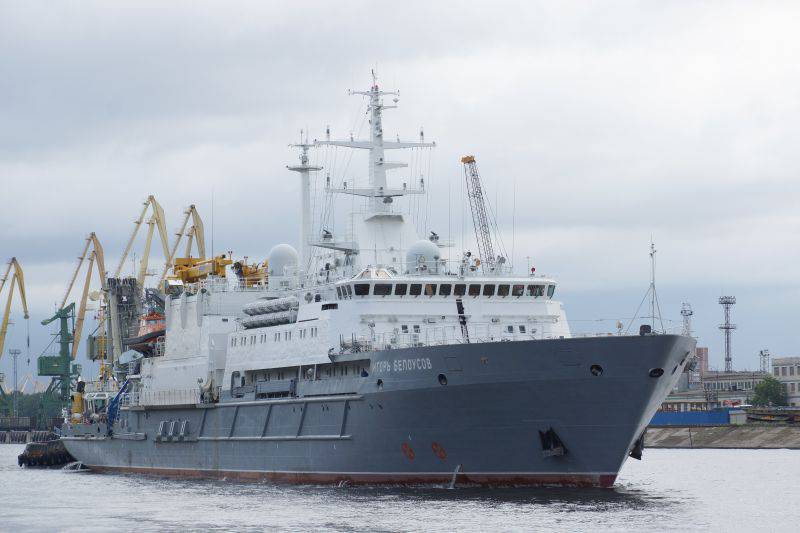
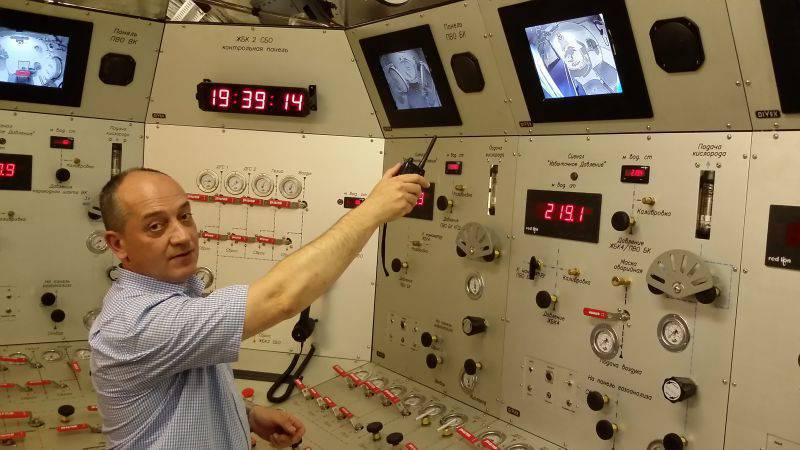
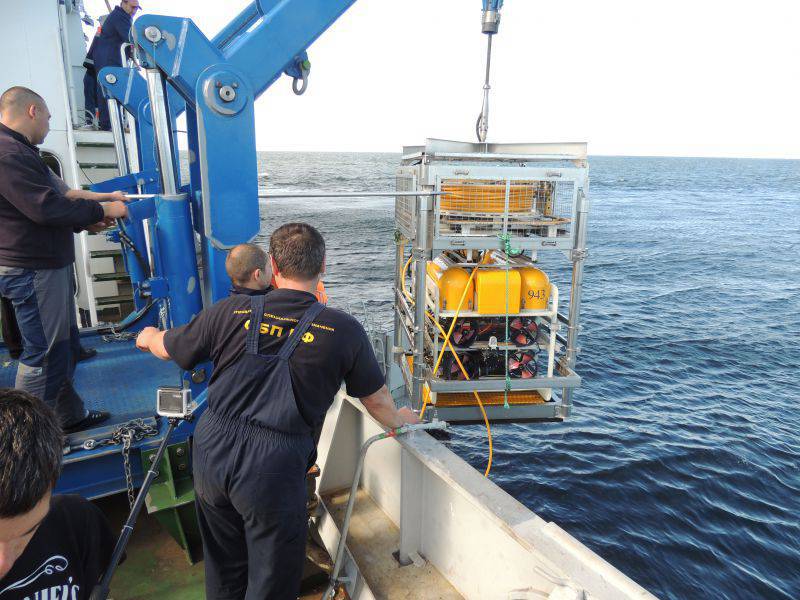
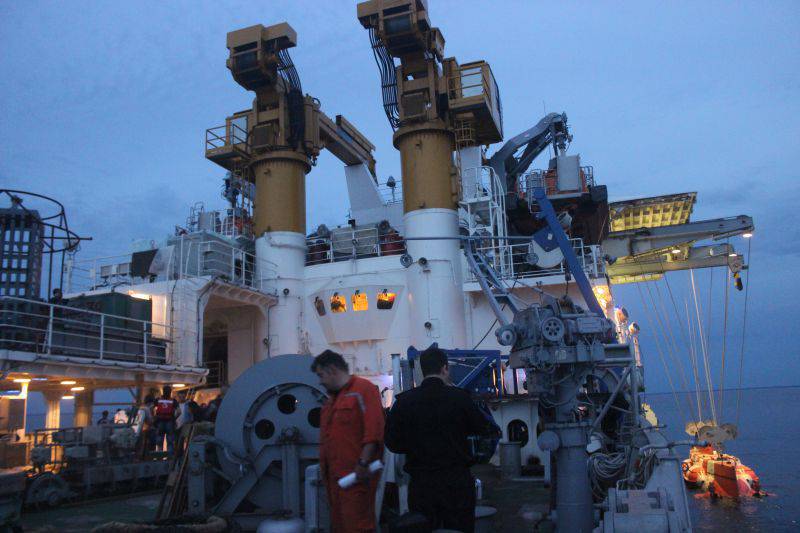
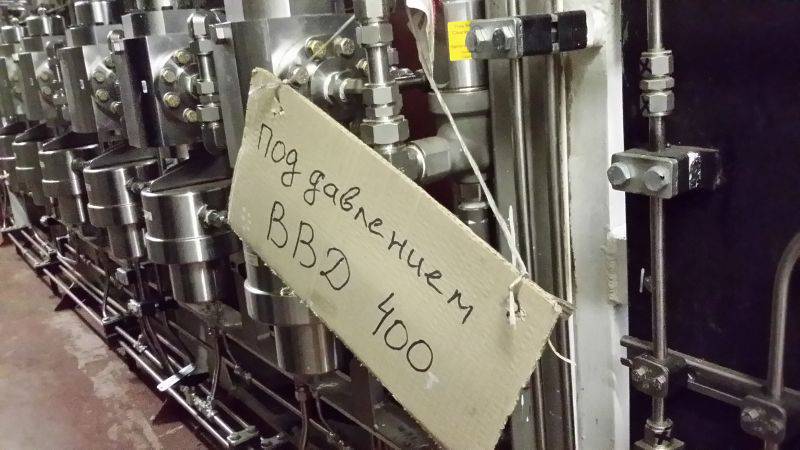
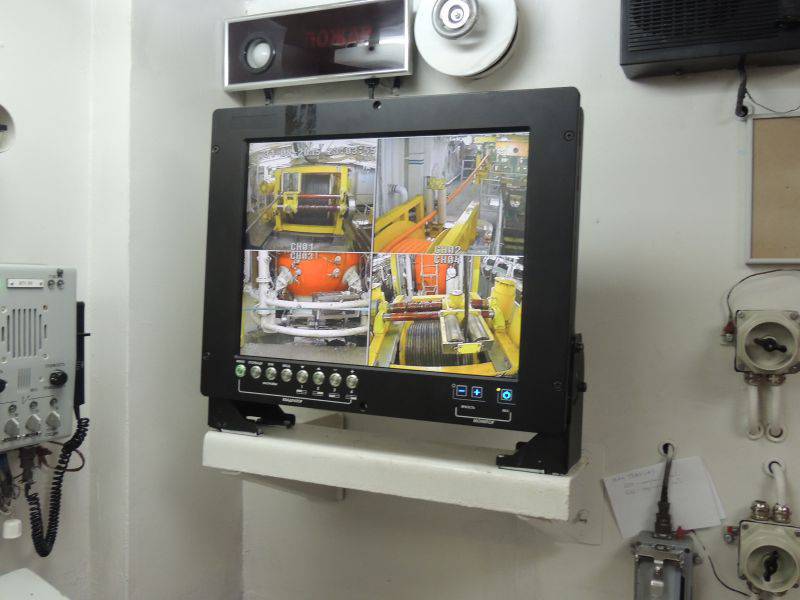
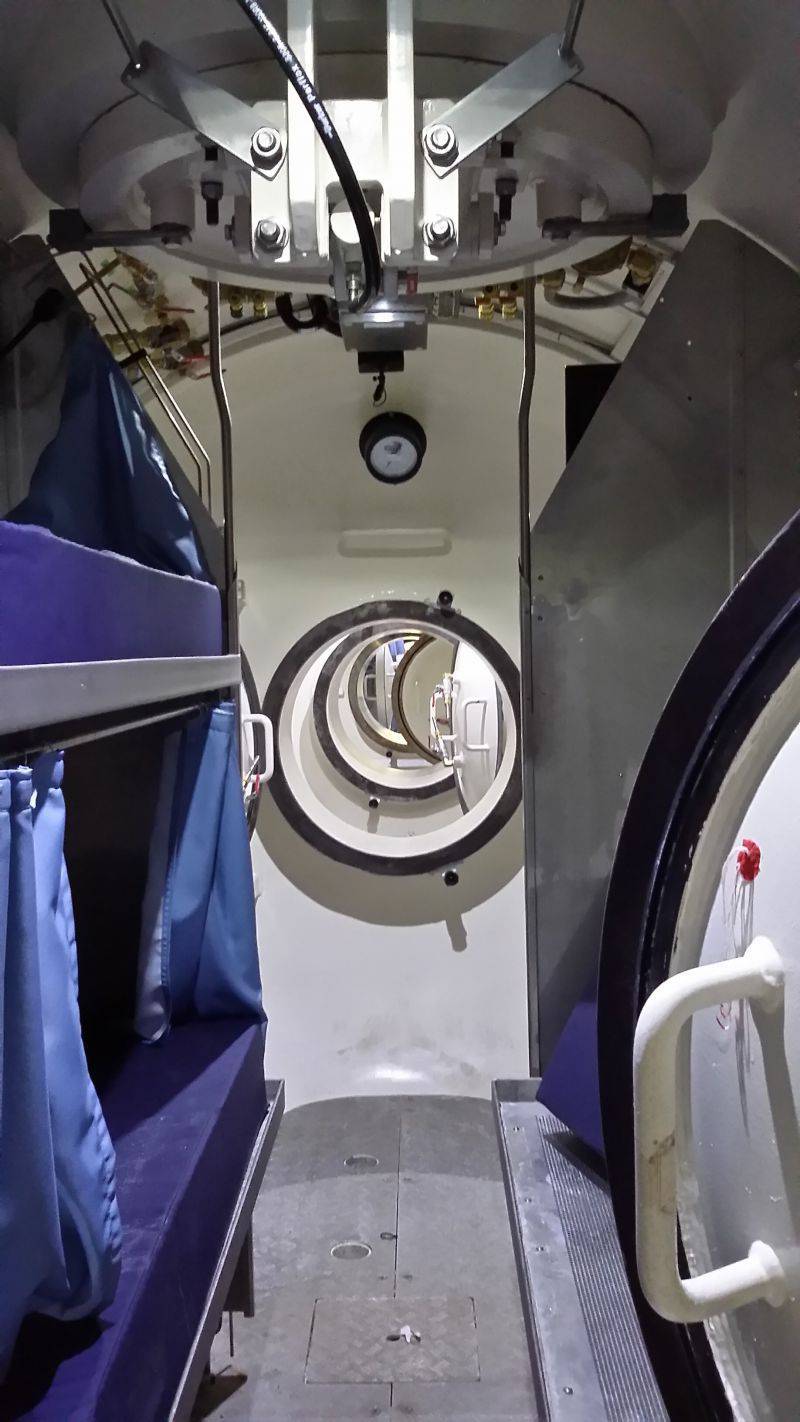
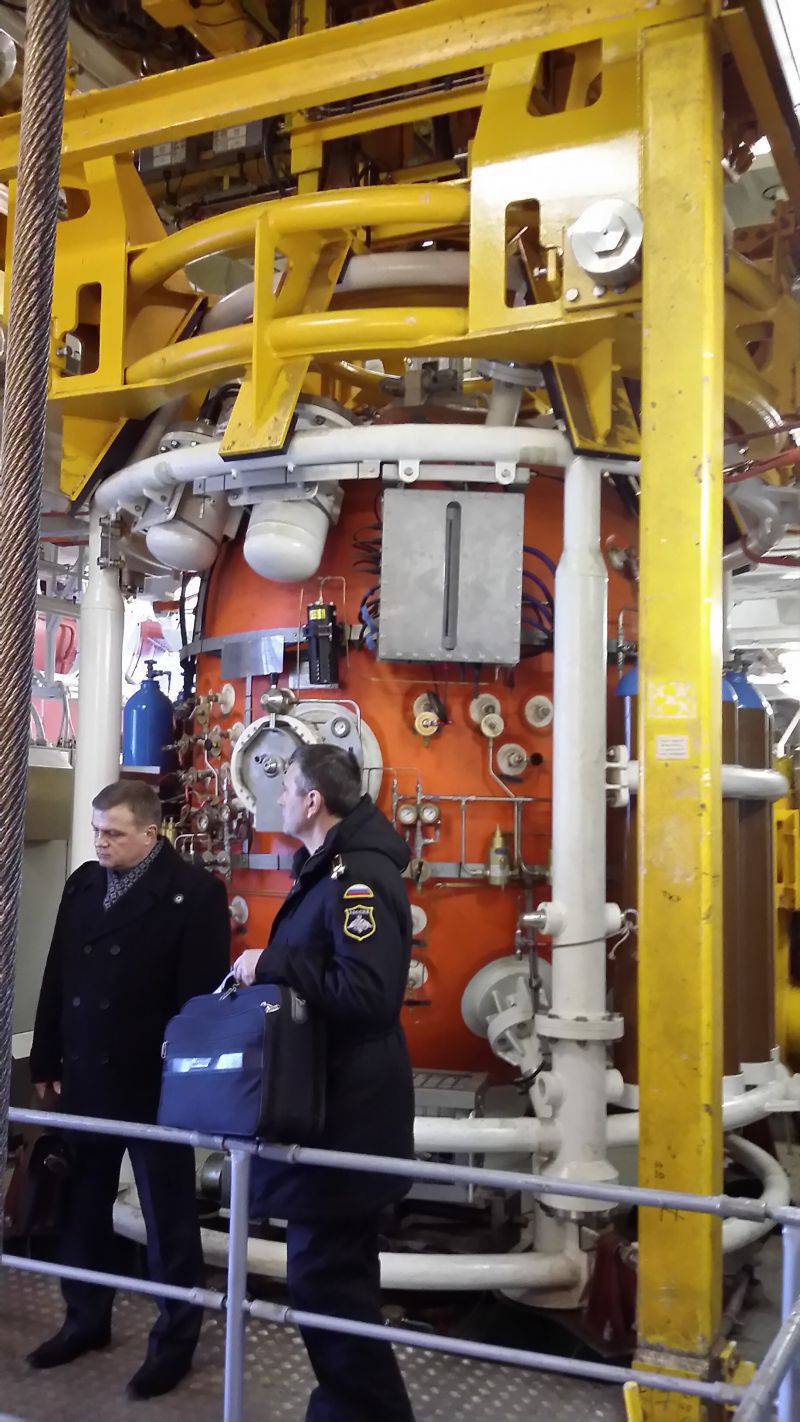
Information